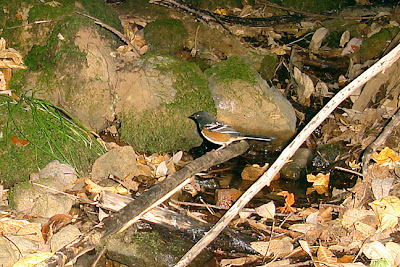 |
| Long-tailed weasel with prey. |
There's a good reason weasels are long and skinny.
It's "essential to the profession of a burrow-hunting rodent predator...", wrote weasel expert Carolyn King.
This photo of hunter and quarry was taken in a mountain beaver burrow, and it would seem to prove the point.
But did this long-tailed weasel kill the golden-mantled ground squirrel in the burrow? Or did it dispatch the rodent above ground and then drag it into the burrow?
Golden-mantled ground squirrels are common in the area, but you find them in dry open coniferous forests rather than the riparian woodland and thickets where mountain beavers dig their burrows.
I've camera trapped this mountain beaver burrow almost seven months in the past 4 years, and the graph shows that golden mantled ground squirrels are not among its users.
I suspect the weasel killed the ground squirrel above ground and dragged it into the burrow to feed out of harms way. That's how weasels operate.
But as the graph shows, a weasel is more likely to encounter a mountain beaver in this burrow than a golden-mantled ground squirrel, and the chickarees and voles down there certainly run the risk of meeting this slinky grim reaper as well.
One other observation: the camera failed to record the resident juvenile and adult mountain beaver during the last sampling period. At least one mountain beaver has always been present.
Has the weasel appropriated this mountain beaver's underworld?
Is its nest now lined with the soft pelts of the previous residents?
I'll update you next month.
 |
| A chickaree shells a fir cone in the underworld earlier this month. |
Reference:
King, C. 1989. The natural history of weasels and stoats. Cornell University Press, Ithaca.











































